How to Get a Solar Yard Light to Work Again
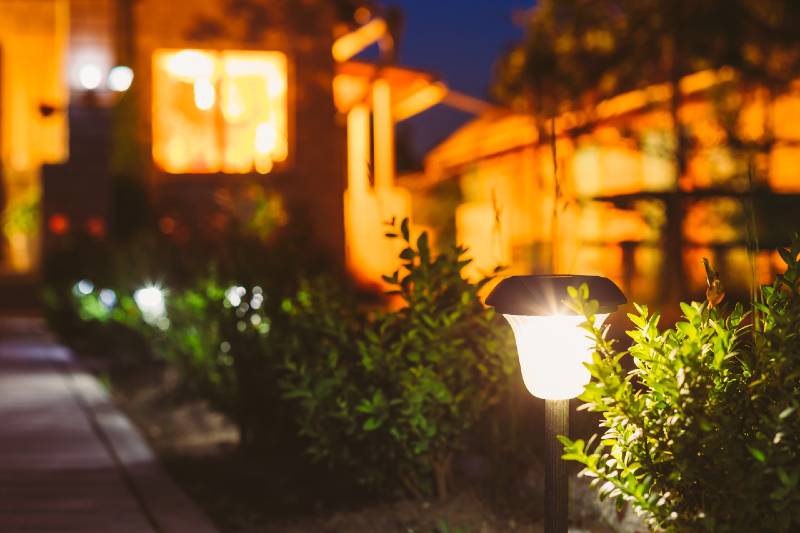
Why Are My Solar Lights Not Working
There are many reasons why your solar lights are not working such as broken wires, dead batteries, no sufficient sunlight, and many more
Fortunately, fixing solar lights isn't rocket science and you still can easily do it yourself from home even if you have zero technical skills.
And to make your life easier, in this article, we will go through all the problems that can cause your solar lights to stop working and how to easily and quickly fix them.
So without further ado, let's dig in.
Solar Lights Main Components and How they Work
In order to fix your solar lights, first, you need to understand how your solar lights work.
In this section, we will give you a quick idea of the main components of solar lights and how they actually work, so let's dive in.
1. Solar Panel
Needless to say, this is the most important part of your solar lights.
Solar panels are responsible for 3 key operations, which are:
- Capturing the sunlight
- Transforming sunlight into electricity
- Passing the electricity to the batteries to store
2. Batteries
Every solar light has one or a set of high-quality rechargeable batteries.
Batteries in solar light are responsible for:
- Storing the charges (electricity) coming from the solar panel so you can use the stored electricity at night
- Powering the LEDs with electricity
3. Sensors
There are numerous types of sensors that can do anything from measuring pressure and temperature to detecting movement.
However, in solar lights, you can find only 3 types of sensors:
- Light Sensor (photocell): This one is responsible for activating the lights when it's dark. In other words, when this sensor detects darkness (absence of light), it gives the order to your solar light to automatically turn on at night
- Lux Sensor: This one controls how dark it has to be outside before activating the light. In other words, it senses light intensity
- Passive Infra-Red (PIR): This one can be found in motion-detecting solar lights and it senses the heat. In simple words, this sensor will activate the light when it senses our body heat.
4. LEDs
They are just flashy light orbs that generate light when the current (electricity) passes through them.
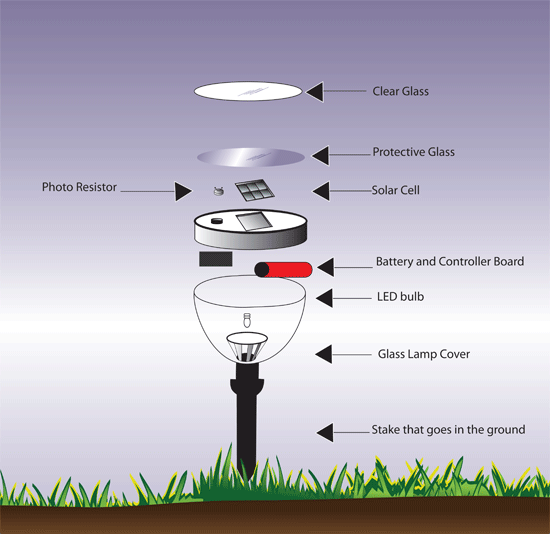
Related article: How Do Solar Lights Work
Reasons Why Your Solar Lights Stopped Working
There are numerous reasons why your solar light is not working and in this section, we will go through the most common issues and how to fix them.
1. Your Solar Light's Battery has a Pull Tab

Most newly purchased solar lights will come with a pull tab on the battery.
A pull tab is an insulator specially designed to prevent batteries and circuits from prior to use energizing, which protects the battery during shipping and storage.
In simple words, your solar light won't work unless you remove this insulator.
Solution: Remove the Pull Tab From your Solar Light
Don't worry, it's pretty easy. All you need to do is to follow the instruction and pull the tab out from under the battery contact and your solar light will work properly.
Here is a quick video showing you how to properly prepare solar lights:
2. Check your Switches and Microprocessor
This might sound dumb, but you will be shocked by how many people who don't know that their lights have an on/off switch.
Note: If you can't find the on/off switch on your solar light, then don't freak out. Some models don't have them.
Solution 1: Check your On/Off Switch
Obviously, if the switch is turned off, you need to turn it on. However, if your solar light is still not working then the classic switch on/off trick might fix your problem.
The classic switch your solar light off, wait for 20 seconds, then switch it back on might sound cliché, but it works 90% of the time. So give it a try.
Solution 2: Reset your Device
Sometimes your solar light's microprocessor (CPU) might get confused, so resetting your solar light might solve this issue.
To reset your solar light settings, kindly check your device's manual and follow the instructions.
3. You Solar Lights Aren't Getting Enough Direct Sunlight
Needless to say, solar lights need sunlight to operate and one of the main reasons why your light is not working is because it receives less than sufficient sunlight.
If your solar lights aren't getting enough sunlight, then it won't be able to fully charge the batteries and as a result, your lights will stop working.
Luckily, in this section, we will provide you with some tips and tricks and show you how to make your solar lights last longer.
1. Place your Solar Lights in a Sunny Spot
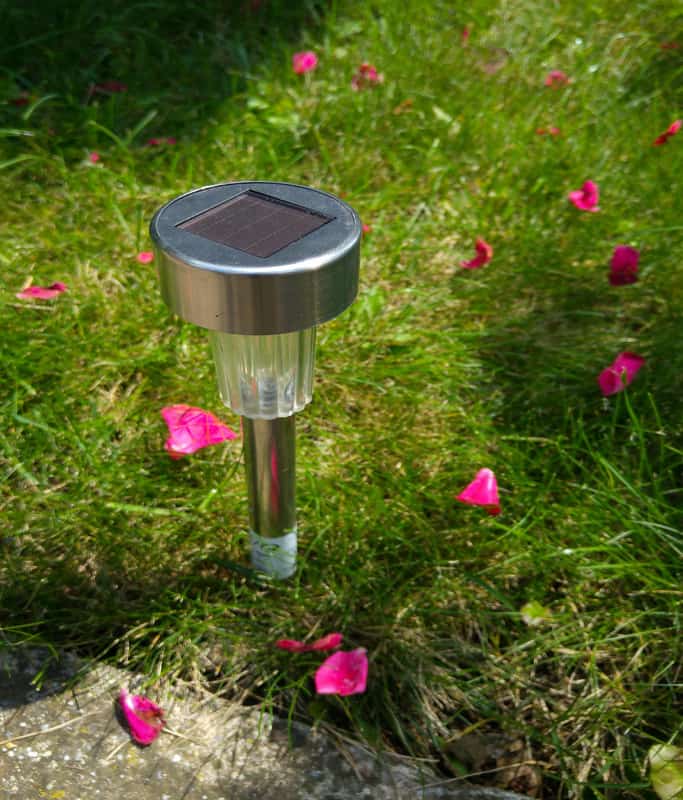
Make sure there are no large trees or buildings around your solar light, as they will cast shade preventing your solar panels from receiving sufficient sunlight.
Don't get me wrong, solar lights will still charge in shade. In fact, you can even charge them using artificial lights.
However, the less direct sunlight they get, the less efficient they will be and the shorter your lights will last at night.
Therefore, if your solar panels are shaded during any period of the day, especially midday, it's highly advised to reposition your solar lights.
2. Adjust your Solar Panel's Angle
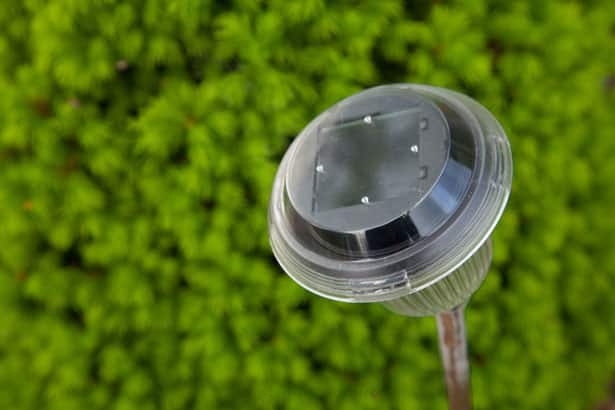
Many don't know this trick, but in fact, your solar panel's angle is very important.
The reason behind that is the sun can get covered by many objects such as clouds, rain, or fog, especially in winter when sunlight is scarce.
Related article: Do solar lights work in winter?
So what is the best angle for solar lights?
Well, the best solar panel angle depends on your geographical location.
However, as a general rule of thumb, you should adjust your panels to 30-degrees in summer and 45-degrees in winter.
Adjusting your solar light's panel to these angels will ensure your panels are absorbing more first sunlight resulting in more energy, which will help to make your solar lights last longer at night.
3. West is the Way to Go

Another small hack, but will make a great difference is adjusting your solar light's panel to the west.
Why should your solar light's panel face west?
Well, think of this, every morning the sun rises in the east, then sets in the west for most of the day.
Now it all makes sense, facing your solar panels to the west will make sure that your lights are getting the most possible amount of direct sunlight during the day.
You don't have to own a compass to know where is west, you can simply download an online compass app on your mobile and you are all set to go.
4. Avoid Glass
This one is a bit tricky, but SOLAR PANELS HATE GLASS.
Can solar lights charge through glass?
Interestingly, solar panels don't function well around the glass, as the glass will reflect the sunlight away from the panels resulting in less sunlight consumption. Thus, less electricity production.
So, make sure to keep the environment around your solar lights glass-free.
It's important to mention that your solar will charge through glass. However, it won't be as efficient as charging your lights using direct sunlight.
5. Use the Energy Saving Mode
Sometimes, during extreme weather, there might not be enough sunlight to charge the battery, so your solar lights will just stop working.
Therefore, some solar lights come with a low/economy lighting mode that will produce a dimmer illumination for a longer duration.
6. Clean your Solar Panels

Dirt and other obstacles can build up on your solar panel preventing it from absorbing direct sunlight.
Therefore, you need to frequently and gently clean your solar lights to make sure there is nothing in the way between the solar panel and direct sunlight.
Note: Clean your panels with a slightly damp piece of clothing without using any random chemicals or additions, as randomly used chemicals can significantly harm your device.
If your solar lights are so dirty that it feels like a lost cause, then check this amazing video on how to clean solar lights within a minute:
4. Check your Solar Panel Cables
Some solar lights have a remote solar panel that's separated from the lamp and connected with a cable or two.
If the cables between the solar panel and the batteries are not firmly plugged in, then the panel won't be able to charge the batteries resulting in a disappointing light show.
Also, you might think I am making this up, but wildlife can be really annoying.
Hungry squirrels might treat themselves with a quick nutritious wire from your solar lights.
Don't worry, unlike ordinary lights, solar lights are very safe and the electric shock won't kill any poor hungry squirrels.
Solution: Fix Broken Wire on Solar Lights

There is nothing a good electrical tape won't fix. However, sometimes the damage can't be repaired and the whole wire needs to be replaced.
For more information on how to fix your solar light wires, check this amazing article on how to fix broken wires on solar lights
If you don't have the technical skills, tools, or even the time, then it's about time to contact your manufacturer and use your warranty.
5. Nearby Light Sources at Night
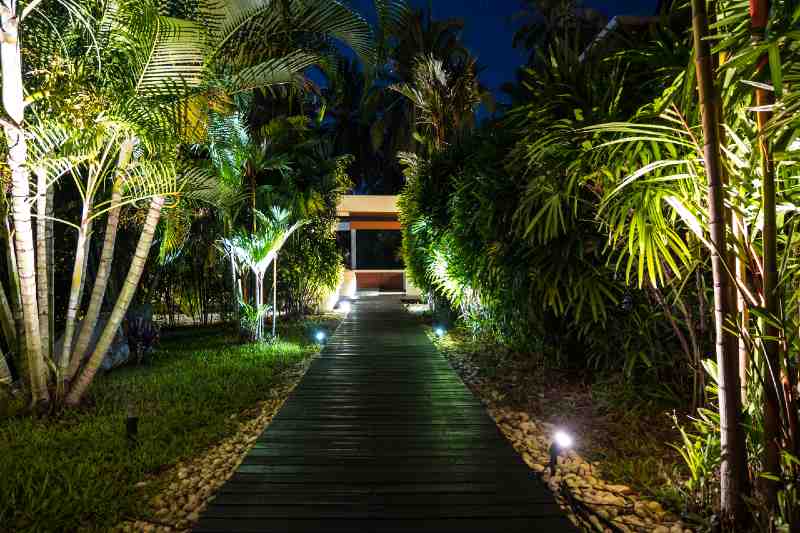
As mentioned before, solar lights have sensors that detect the light, which is the component responsible for automatically switching on the light at night.
When these sensors detect (sense) no lights they give the order to the bulb to work.
Here comes the problem, having other nearby light sources at night will fool the sensors making them think we are still in the morning.
As a result, the sensors won't allow the lights to function and your solar lights will not work.
Solution 1: Adjust the Lux Sensor Sensitivity
The Lux sensor is another photocell that determines how dark it has to be outside before activating the light.
This can be really helpful, especially if there are other sources of light like neighbor's lamps tricking your solar light into thinking that it's still daytime, which will prevent your solar lights from working.
How to adjust solar light Lux sensor?
Well, Lux sensors will have a picture of the sun and the moon.
- Sun: Turning the knob towards the sun picture means that your lights should work when it's brighter outside
- Moon: Turning the knob towards the moon picture means that your light should work when it's darker outside
Now, all you need to do is to adjust the sensitivity by fully turning the knob towards the moon picture and then turn it slowly towards the sun picture till the light works.
Note: It's important to carefully adjust the sensitivity because if you fully turn the knob towards the sun picture, then your light might start working from 5 PM and this will highly drain your batteries.
Solution 2: Eliminate Competition
Make sure there are no other light sources such as street lights, neighbors' lights, or even other solar bulbs around your solar light.
Further, you can simply cover or rotate the solar panel away from the lighting source and you will be just fine.
6. The Passive Infra-Red (PIR) Dials (Motion Detector)
Most motion-detecting solar security lights will work if a cat or squirrel passes by them. However, the most advanced solar security lights have adjustable knobs that control the motion-detection sensitivity.
In other words, this knob can be adjusted to stop cats, birds, squirrels, or any other wild animal from triggering the light.
Sometimes, your knob might be on minimum sensitivity by default so you need to fix that.
Note:
- High sensitivity: This means your sensor is hypersensitive and it will detect the smallest of objects such as birds and squirrels
- Low sensitivity: This means your sensor is clumsy and it will only detect big objects like humans, bears, and sometimes big dogs
Solution: Fix Your Solar Light Motion Sensor
There is no such thing as the perfect sensitivity level, it all depends on the distance you wish your lights to detect.
You can simply figure out the best sensitivity by using the good old trial and error.
Start with maximum sensitivity, then work back from there till you find the most convenient sensitivity for you.
7. Faulty Lights Sensor
If your solar lights are not working at night, then it's very likely that your light sensor is the problem.
To test your sensor, simply cover the photocell with your hands or use a dark piece of clothing.
If the light turns on, then your sensor is just fine, if not then it's either your batteries or your sensor needs to be fixed.
Solution: Fix Your Solar Lights Sensor

To fix your sensor, the first thing you need to do is to clean it carefully and test it again.
Simply disassemble your solar lights and clean the sensor thoroughly with a damp piece of cloth without any chemicals. If you are against some tough to clean debris, then you can use a special electronic cleaner spray.
Before reassembling, make sure to dry your light completely, as any moisture can damage the internal electronics.
After cleaning and assembling your light, now it's time for testing.
Just cover the sensor with your hands, if the light turned on, then congratulations! You just fixed your faulty sensor. If not, then your sensor is broken and you need to replace it.
8. Dead Batteries

People tend to forget that their solar light's rechargeable batteries have a lifespan of less than 1000 charges (roughly 3 years).
During this period your batteries' charging capability will gradually decrease till they become totally faulty.
How to know if your solar light's battery is losing its capability?
Well, you can easily tell if you notice a big decrease in your solar light's runtime.
For example, if the first time you operate your solar light it used to work for 10 hours and now it can only work for 5 hours even after a good sunny day.
Then that's a sign that your batteries are losing their charging capacity.
Therefore, if your solar lights are not working or it's not performing as it used to be and all the previous methods didn't work out, then it's very likely that you need to replace your batteries.
Here are a few tips and tricks that will help you to fix your solar lights batteries
1. Try the Deep Charge Technique
Sometimes, your batteries just don't have enough charge to power the light. Therefore, trying the 72 hours charging technique might be worth the shot.
This technique is all about helping your batteries to reach the full charge point by turning off your lights and allowing your solar panel to fully charge your batteries.
All you need to do is:
- Switch your solar light off
- Place it in a sunny spot
- Wait a couple of days
- Try your lights
Note: We recommend you to do this more regularly, even if your solar lights are just fine. As this technique helps your lights to get a full charge, which highly increases your battery life.
2. Replace your Batteries
First, test your solar lights with normal batteries (same voltage).
If the light works, then it's clear that the problem is either your batteries can't hold the charge (faulty), or the solar panel is broken -hopefully not-.
You can also test your rechargeable batteries by using them in any battery-powered device if applicable such as your wall watch or something.
For now, it's about time to replace your batteries and see how it goes.
Note: You have to make sure your new rechargeable batteries have the same voltage and capacity as the old ones.
9. Water and Residue Buildup

Yes, your solar lights are water and weatherproof, yet, they are not invincible.
Sometimes, water or dust might build up inside your solar lights resulting in displacement or even wear of wires.
Although, it's very unlikely when your solar powered lights have an IP rating of 65 or above, it's still possible, especially if you live in a harsh weather area.
Solution: Dry your Solar Lights
- Open your solar light and gently clean it from all the residue
- Re-assemble your light and switch it off
- Keep it under in hot temperature (sunny spot or something) and give it time to dry off all the wetness
10. Your LEDs are Faulty
It's very unlikely, as LEDs tend to have a very high life span and can last for up to 50,000 hours (6 years) but it's worth testing.
Solution: Fix your solar lights' LEDs
As usual, you need to test your old LEDs first. If it's not working, then buying new LEDs might be a good idea.
Your Last Resort
Different brands have different designs and it can be impossible to cover all the solar lights brands and their functions -unless you want to read a 50,000 words article-.
Therefore, if none of the previously mentioned tips seems to work, then you should contact your manufacturer and ask them for help or even use the "warranty card".
FAQs
1. What does it mean when solar lights blink?
If your solar light is flashing, then it could be one of 3 reasons:
- The wire connecting your battery and LEDs is loose
- Your lights are on the flashing mode
- The battery don't have enough charge (almost empty)
2. Why is my solar light on during the day?
If your solar lights are on during the day, this only means that your light sensor is broken.
Don't worry, this problem is pretty easy to fix. All you need to do is to disassemble your light, clean your sensor thoroughly then reassemble and test it again.
If it's still broken, then you can simply replace the old sensor with a new one and your solar powered light will work just fine.
3. Why do solar lights only last a year?
Most cheap solar lights will only last a year because of the battery.
Most of the batteries used to manufacture these lights lose their charging capabilities so quickly.
Luckily, your solar lights aren't dead yet, you can simply replace your battery with a better and even higher mAh one, just make sure the new battery's voltage ad current matches the previous one.
Last Words
Whether it's your panel, batteries, wires, or even sensors, you still can fix your not working solar lights and bring them back to life by yourself.
As promised, in this article, we provided you with 10 things that can cause your solar lights to stop working and their fixes.
In the end, we really hope you enjoyed this article, and stay tuned for more awesome tips and hacks from Solar Energy Hackers
Did you find this article helpful? Did you try any of these tips? Do you have any tips you wish to share with us?
Please let us know your thoughts in the comment section below.
Source: https://solarenergyhackers.com/why-your-solar-lights-not-working-and-how-to-fix-them/
0 Response to "How to Get a Solar Yard Light to Work Again"
Post a Comment